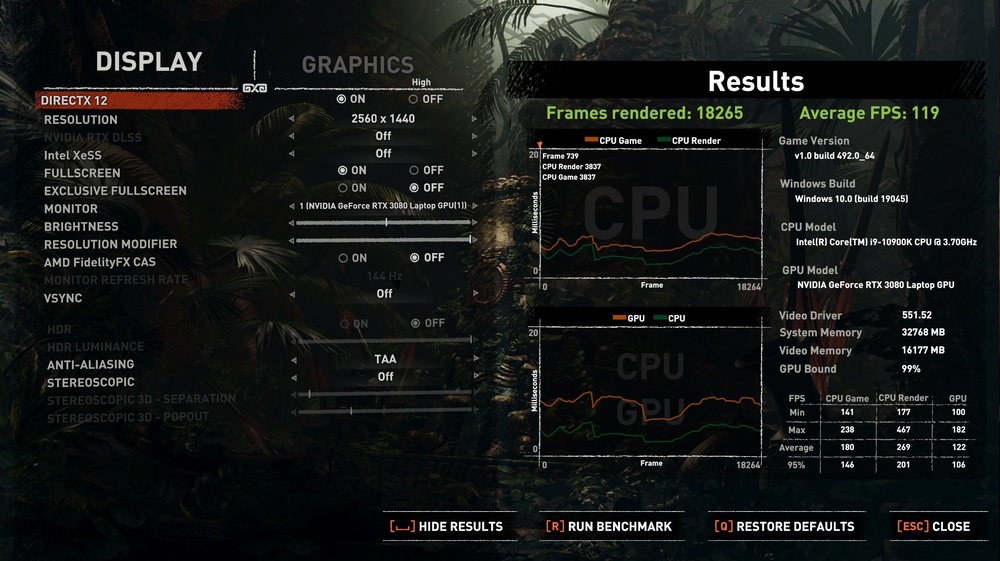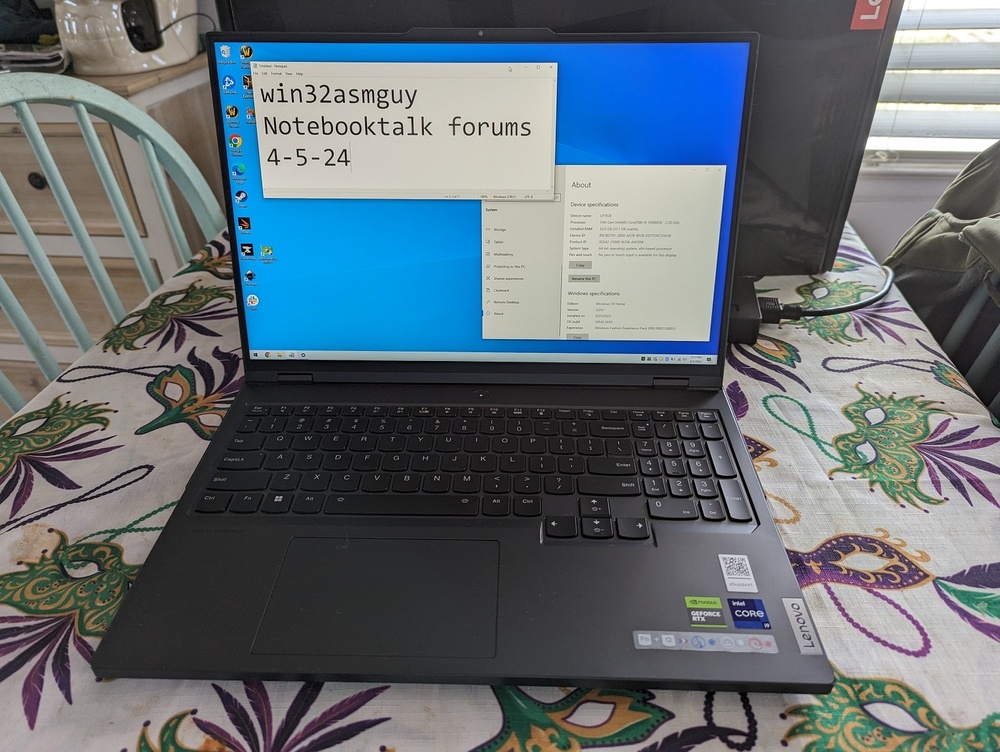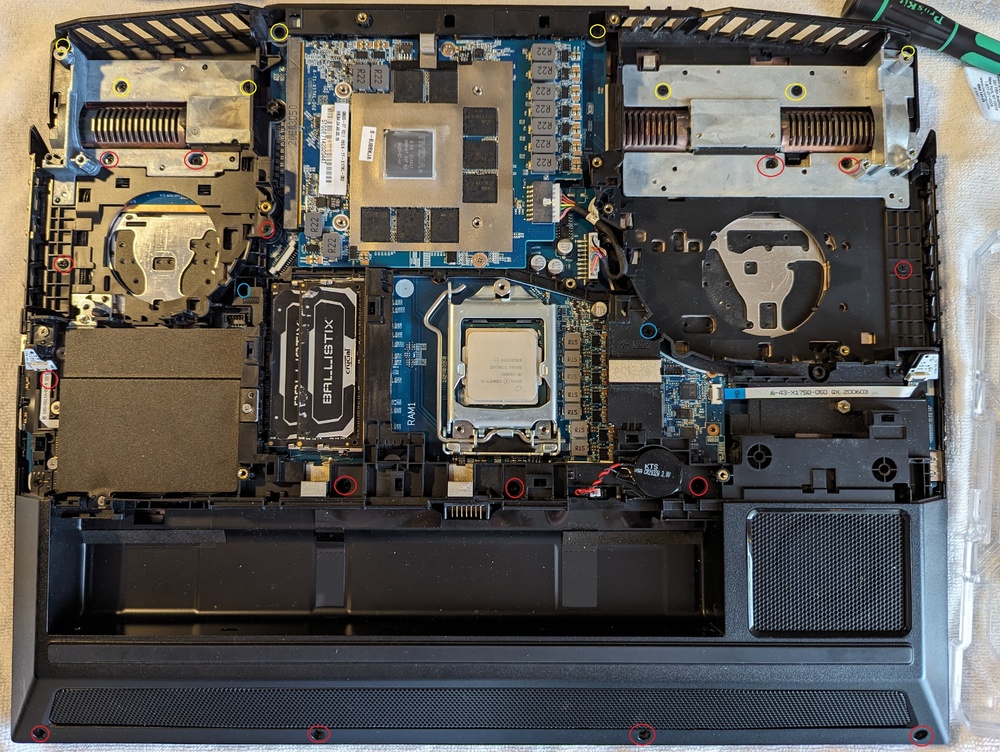
win32asmguy
Member-
Posts
652 -
Joined
-
Last visited
-
Days Won
3
Content Type
Profiles
Forums
Events
Everything posted by win32asmguy
-
*Official Benchmark Thread* - Post it here or it didn't happen :D
win32asmguy replied to Mr. Fox's topic in Desktop Hardware
If you happen to go the Linux-friendly laptop route I would suggest the System76 Oryx Pro 12. It is a Clevo PE60 chassis which is their only model with a vapor chamber. The firmware (both BIOS and EC) can be customized so it is closer to a desktop mainboard in that regard. I have the X370 myself but it has an inferior cooling system unfortunately so it has trouble with maintaining high combined loads. It is sad that the X170 has such a better cooling system than the X370. They literally cut the z-height in half from one generation to the next which was completely unnecessary for a "flagship" model. -
Glad to see another 3080 mobile upgrade in the works! Mine has the same wear on the memory and its fine. I think its just an effect of the thermal pad grease at normal operating temperatures. Your current GPU should look the same way. My intial heatsink I ordered from RJTech / Sager was also bent upon arrival. I had to take many photos of the box and heatsink and they sent another out which arrived a week later that was actually double boxed and not bent. It was still faster than other options due to chinese new year going on at the time.
-
Disappointing to hear. His video was also made on the initial bios version so now things may need some other settings changed to get any benefit from undervolting. Its dissapointing because the HX chips are supposed to all be unlocked parts that we are definitely paying for their price, yet we see many implementations where Intel and an OEM has a double standard compared to an unlocked desktop chip of the same name. I personally consider MSI Center and any other similar preinstalled OEM software to be intrusive and unnecessary. Half of the time the features they support are buggy or become broken randomly by an automatic update. I tested out a 12th Gen GT77 but ended up returning it because the EC would periodically reset the fan table to its default value and MSI couldn't give an answer if they would even fix the issue in a future EC version. Now I just use the System76 machines with an open source BIOS and EC so I can just modify the fan table to my own preference without needing control software in any OS.
-
I had been following that issue (also from the post in the Windows section) and hoped a reasonable solution had been found. My thought was maybe Speedshift EPP had been erroneously manipulated by either a Windows update change, MSI Center or potentially even the EC. I do know that MSI pushed a bios update for the GT77 13th Gen last year that now limits sustained CPU TDP to around 120W regardless of the GPU state, CPU temperature or any other metric.
-
My X170SM is tuned to not go over 45db under load. That is part of why it's cooling system is so great as it can do 225w at a very reasonable noise level. I have considered adding noctua fans to my cooler master u3 plus to see if it adds more airflow for little added noise.
-
Here is Shadow of the Tomb Raider and Horizon Zero Dawn on my 150W 3080 mobile. Same card gets about 12k in Timespy as well: https://www.3dmark.com/spy/46227717
-
I purchased mine from rjtech for 269usd plus shipping. I went back and forth with a few AliExpress / eBay sellers but they ended up not having it in stock and shut down for Chinese new year.
-
Price: 2100usd + shipping SOLD locally Condition: Like new. I used it primarily as a DTR only. Warranty: Through 6/20/24 Reason for sale: Switched to X170SM Payment: Paypal, cash if local Item location: Loveland, CO Shipping: UPS or Fedex depending on your preference International shipping: PM me to discuss Handling time: 2-3 days Feedback: I have sold many laptops on the old NBR forums, but not here yet! Specification: 13900HX 4090 mobile 32GB (2x16GB) DDR5-5600 1TB SSD 240hz QHD Windows 11 Home Proof of ownership: Time Stamped pictures
-
In theory even the stock Clevo X170SM bios should boot with the 3060/3070/3080 mobile installed, just no Dynamic Boost, GSync and the driver has to be manually installed on Windows.
-
Thanks, although I think Q0/G1 is actually the stepping. My microcode version is CA according to HWInfo64. From what I have read from some enthusiast desktop forums maybe version EC is a good balance of performance and stability.
-
The performance is on par with 2080 Super mobile from my test results: https://www.3dmark.com/compare/spy/45874152/spy/45854327 3080 mobile has 16GB memory, better 8nm process node, supports resizeable bar, better CUDA core utilization with FP32/INT32 redesign. Dynamic boost 2.0 needs Nvidia PCF support in the ACPI tables, which did not exist in the X170SM bios. Gsync is enabled by a driver whitelist which uses combinations of machine identifiers, vbios identifiers and display EDID identifiers. Fast Sync still works as an option for games configured to meet its criteria.
-
It sounds like the Nvidia GPU may still be active based on the CPU power consumption. Double check these things: - Nvidia GPU and its audio/usb devices must be enabled in device manager in order to reach the lowest power state. - Overclocking apps like MSI Afterburner must be disabled as they keep the Nvidia GPU alive. At one point I even found the Intel "Command Center" tray icon to be keeping the Nvidia GPU alive as well! - Fresh boot after having all external displays connected so the Nvidia GPU isn't determined to be the primary by the OS - Try clean installing a dell supplied driver to ensure it has any OEM specific tweaks they apply. Upgrade from the dell driver (not clean install) if you need driver specific fixes which usually keep the OEM tweaks intact
-
I have been using Alphacool Subzero on mine, just because I had noticed it was what XMG used on the X370 so I wanted to test it out. Seems to work as well as Phobya Nanogrease Extreme. I will likely switch to PTM7950 after I am done testing bios changes and do not have to worry about a full dissassembly to make a recovery flash to the SPI chip. My temps on the X170SM have been 89C on the CPU under load, and up to 75C on the 3080 mobile (85C on the hotspot) with it pulling 150W. I also have the aftermarket fans from the Taobao seller, but have their speed limited to 50%.
-
*Official Benchmark Thread* - Post it here or it didn't happen :D
win32asmguy replied to Mr. Fox's topic in Desktop Hardware
I finally have some parts collected to build a desktop system to use as a media encoder and server. I can put the delidded 12900KS to use that I have had over a year now from the NH55 sitting in a box. Got a MSI Z690-A, 32GB DDR5 6400, Noctua D15 and a 2TB WD850 that I will use as a boot and scratch drive. I still need to figure out what I want to do for media storage drives, not sure what is the best for that use case these day. This system will have to run Windows 10 so far as I can tell as Makemkv seems to not support Linux. Hopefully it will not be very noisy while encoding as it will sit near our TV and couch. Right now I have an external laptop bluray drive but hope to get a faster internal drive so long as its somewhat quiet while ripping. I will note it is also hard these days to find a nice case that still has a 5.25 drive slot! -
Yes, my X170SM is from System76 using their open firmware. I was also going to ask you what CPU microcode Premamod is using. Mine is using an older version CA but I have heard that EC may be better. By using a custom profile I did get my HyperX 32gb dual rank kit working at 2933 cl17 1.2v. Originally I was trying for 3200 cl18 1.35v but that would not boot with a stick in channel A.
-
I tried the other combinations including just a single stick installed at a time but everything was throwing errors. I also temporariliy reinstalled the 10600k to test and it did not improve stability with the Ballistix kit. I was talking with one of the System76 employees and it sounds like there may have been a firmware issue with memory configuration as he was not able to get 128GB stable at 3200 or even 2933 which was possible with the priorietary firmware on the same hardware. Maybe the same configuration issue also effects dual rank at lower capacities. I guess 2666 C15 dual rank is stable, but I was hoping for 3200 C20 or better to work.
-
I have both an x170 and x370. The x170 can easily sustain 250w loads at 45db while the x370 struggles with 215w at 60db. It also has worse speakers, high pitched fan noise, a worse feeling trackpad and keyboard. The x370 chassis gets very hot to the touch and I find the x170 much more comfortable to use on my lap despite it being heavier. The sad part is the x370 could be thicker but isn't because someone decided that thinner is better even if it compromises performance.
-
It is both better and worse. Everything is configurable as both the bios and ec are open source. However there are no traditional bios menus to make adjustments so you have to be a software engineer familiar with C and Coreboot/FSP/EDK2 toolkits to really make use of it. These are also special ordered from Clevo from what I can tell without Intel Boot Guard active, as the bios is not signed. Some work they have put into changes might be appreciated, like the Intel ME being fully disabled for instance. You can also completely disable Intel DPTF. They have also added support into the bios to apply the amplifier chip EQ settings so the speakers sound great without needing any additional configuration in Windows or Linux.
-
Here is a video review / contrast Eluktronics posted of the MSI Titan 18 with the new Hydroc 16 (same as the Neo 16 E24 I believe):
-
Yeah I am going to try some other combinations this weekend. Just to clarify, slot 3 is the one closest to the motherboard and slot 1 is the one above it, correct?
-
*Official Benchmark Thread* - Post it here or it didn't happen :D
win32asmguy replied to Mr. Fox's topic in Desktop Hardware
Interesting to hear that about the 12900k, especially given that it ran much cooler than the delidded 12900ks I also had. I kind of get the feeling that by the time the ks chips are announced they start keeping the good k chips for that bin. At least that chip had a better IMC and had no trouble running 3200 speeds with dual rank. -
I have not had much luck with the Ballistix kit so far. With XMP enabled it was only stable with a single stick in slot 1. It does train with both sticks installed but just crashes while booting up or a few seconds after. I read that in desktop overclocking usually increasing VCCIO and VCCSA can improve memory stability. Unfortunately those voltage rails are neither readable. From the schematics it seems like VCCIO is 1.05v and VCCSA is 1.1v and both have overcurrent protection set just slightly higher so no tolerance for overclocking.
-
Palm rest / lid removal guide (useful for getting access to the bios chip): 1. Remove bottom panel, battery, CMOS battery, and heatsink. 2. Remove 15 screws highlighted in red and two screws highlighted in blue. Note that the screw near the SSD cover is under the ribbon cable for the RGB module. 3. If you are removing the lid, remove the eight screws highlighted in yellow. 4. Turn the machine on its side and push out the keyboard. 5. Open the lid and disconnect the keyboard, removing the two screws for the interposer board. 6. Disconnect the five ribbon cables under the keyboard tray. 7. Unsnap the palm rest from the top left and right corners, it should lift off. 8. If removing the lid: a. Remove the back bumper from behind the screen, it unsnaps from the rear edge near the ports. b. Remove four silver screws now exposed and four black screws on the other side of the screen near the hinges. c. Remove the eDP, wifi and camera cables from their channels closest to the hinges (it is not necessary to disconnect them). d. Remove the four screws (two on each hinge) setting the screen down where the palm rest used to be. e. Now the plastic fascia below the hinges can be removed. There are also two plastic pieces that limit how far the screen can open that can also be removed. f. An indentation in the plastic fascia can be cut out so a SOIP8 pomona clip can be used without removing the lid next time! Feel free to let me know if there are any questions. I am pretty sure the process is the same on the X170KM as well.
-
I made this nifty 2 to 1 box plug tip to 5.5x2.5mm tip adapter so I can use the X170SM with a single SlimQ 330W adapter. It works although you must cold boot the laptop with the plug inserted in order to get full power on the CPU. Obviously I need to make a second revision with cleaner soldering but it could really be a nice option for taking the X170SM on the go!
-
Yeah I pulled the chip and looked at the pads and pins which all seemed fine. I am using the X170KM heatsink and its included spring loaded screws for 3080 mobile compatibility reasons. I did find a 32GB Crucial 3200 CL22 single rank kit which booted in slot 1 and 3 with the 10900k. I also had a 64GB OLOY 3200 CL22 kit from another machine that would not boot. I will note that both the OLOY and Kingston Fury 64GB kits both use SK Hynix ICs while everything else is either Micron or Samsung. I also happened to find a used Crucial Ballistix 32GB 3200 CL16 XMP kit so I can test that out this week. Maybe the extra voltage will help with 3200 speeds.







